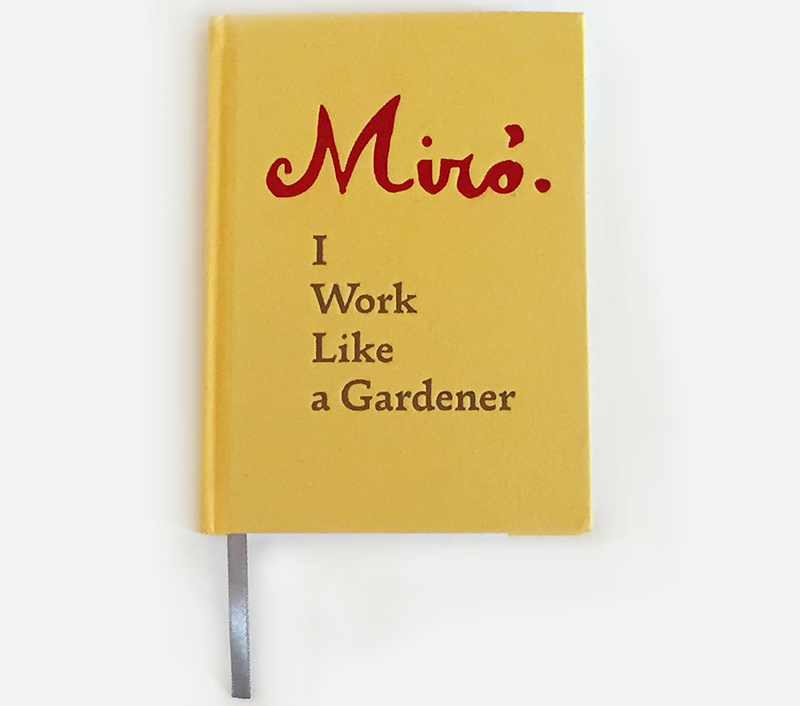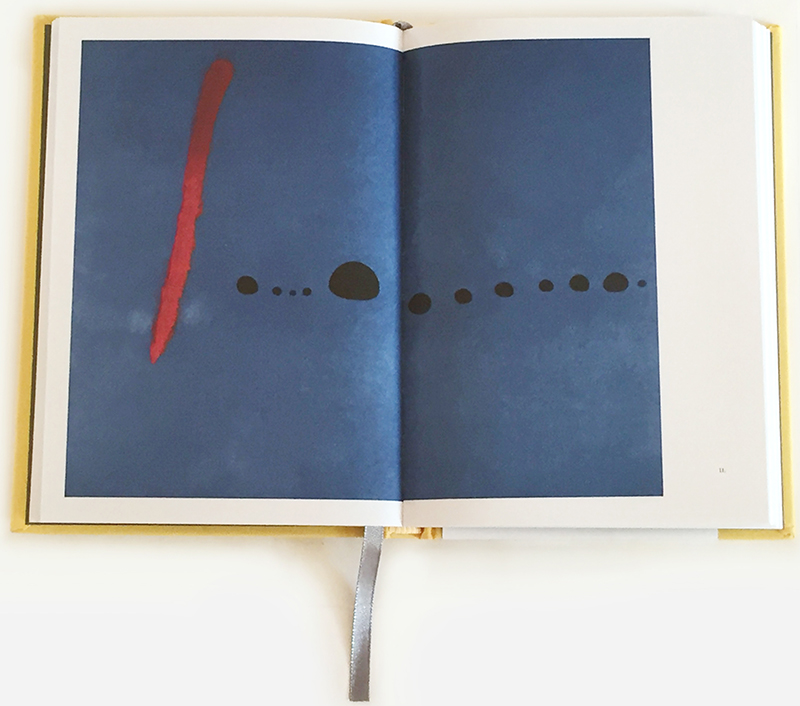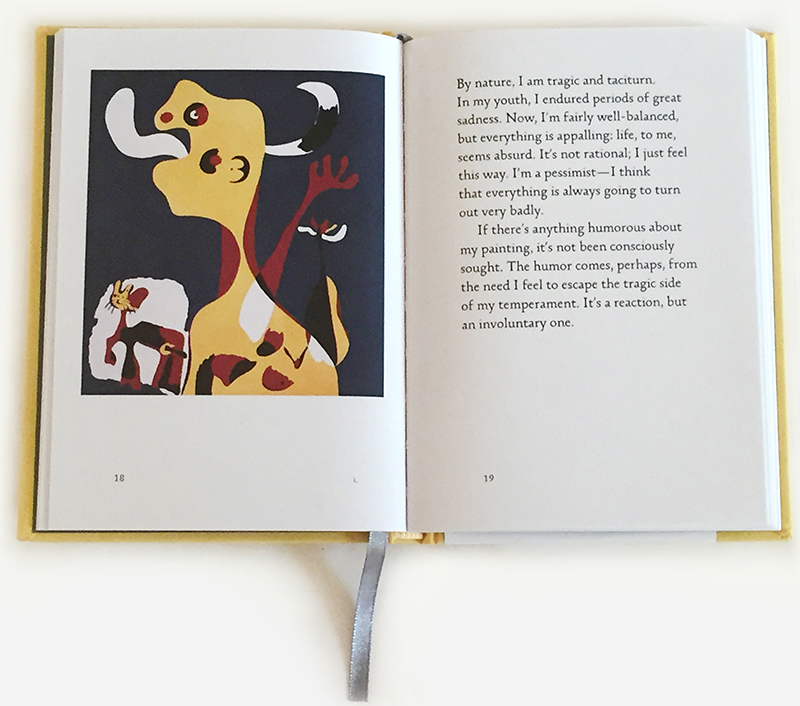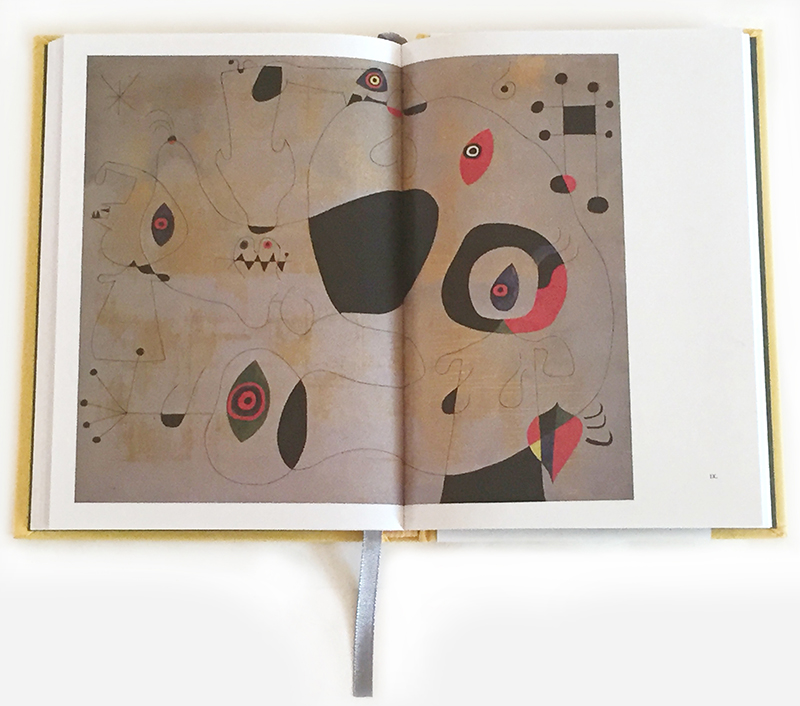Yet, Miró describes his own work as something like that of…a gardener. What work could possibly be more down-to-earth, more grounded in blunt realities than gardening? Did Miró deny the label of “Surrealist”? Or was it that he perceived an alternative reality of gardening, one that matched his view of his artistry? What was his attitude towards his work and art?
These questions have been examined for decades, though somewhat inaccessibly. Joan Miró: I Work Like a Gardener, a collection of Miró’s remarks compiled by critic Yvon Taillandier, was published in 1964 as Je travaille comme un jardinier. Those of us able to read French and attain one of the limited editions could explore the mystery behind the title.

But now this collection of Miró’s thoughts will become widely available. Published by Princeton Architectural Press, this English version allows us a glimpse into the artist’s relationship with his art. It shows how his philosophy manifests in his work—both in the tangible sense of his creations, but also in the trajectory of his career. And perhaps most remarkable, this edition makes apparent the artist’s fascination with paradox and irony—in part through Miró’s own words, and in part through the sensitive editing and presentation of Miró’s words that accentuate his meaning and concentrate his essence. In addition to the original foreword by Yvon Taillandier, this new edition includes a preface by Miró scholar Robert Lubar and is designed by Paul Wagner, who generously shared with me some of the reasoning behind the design decisions.
Unlike many books, this volume unapologetically features the preface and foreword with equal typographic emphasis as the main text by Miró. Wagner described this book as “basically these short meditations on how [Miró] works.” That these three sections are similarly designed subtly reinforces Miró’s message that “art can die; what matters is that it scatters seeds on the ground.” In a sense, the preface and foreword are both seeds scattered from the mother plant, Miró’s original remarks, and the nearly equal typographic emphasis presents them with equal prominence.
The preface leads us to our first insights into the title’s significance. Lubar draws parallels between the physical labor of gardening and cultivating creativity, the development of ideas and seeds, the environment of a studio and that of the natural landscape, and an artist’s materials and the physical elements composing our world. He leaves us with: “To work like a gardener was to create life itself—the autonomous life of a visual universe that, in [Miró’s] words, was a world set in motion.”

Of course, ironically, what we are propelled towards next isn’t immediately the main text. Instead, we slip into the foreword by Taillandier.
Just as Miró describes his studio as a “kitchen garden” where he must occasionally prune what grows forth, Taillandier’s editorial approach is to “intervene only with caution, and only to ensure that the shape of the written tree, as much as it can be, is an offshoot, like that of the spoken tree.” We can trust that words placed in such an editor’s hands will be handled sensitively and gently. But we also know that we hold carefully, intentionally designed words—intentionally designed out of a self-conscious loyalty to retaining an original. Fittingly ironic.
Together, the preface and foreword provide us with both the context and the clues about what we may expect from Miró. But we also experience another element important to framing and representing Miró’s philosophy: the book itself, as a designed object.
Miró was keenly aware of what tangibility does for people. In his early 20s, he attended Francisco Galí’s art school, where Galí blindfolded him and told him to touch the objects he was going to draw. This tactile relationship to art is apparent in Miró’s words in this book:
For me, an object is alive; this cigarette, this matchbox, contain a secret life much more intense than that of most humans. I see a tree, I get a shock, as if it were something breathing, talking. A tree, too, is something human.With its clothbound cover, embossed cover lettering, and satin bookmark, this edition is a tactile delight. The interiors are visually textured; the text is set ragged right and at a generous size on each page, as if allowing the text to run and breathe freely, and enabling us to scrutinize the nuanced details. The typeface is FF Parango, which Wagner chose because it “just seemed right for the text and for Miró’s work.” (Fittingly, Miró also described his artistic choices as “a kind of reckoning, a journey across uncharted terrains guided only by instinct and intuition.”) But FF Parango is a face that, according to FontShop, “evokes the feel of ancient printed pages; yet its crispness keeps it distinctly contemporary.” Perhaps it is this paradox, true to Miró’s affinity for juxtaposition, that guided Wagner’s instinct to choose this typeface.

Unsurprisingly, Miró’s attitude about inspiration seems also to have been based on a keen awareness for tangible objects and a perception of paradox in finding inspiration. He writes,
I begin my pictures under the effect of a shock that makes me escape from reality. The cause of this shock may be a tiny thread sticking up from the canvas, a falling drop of water, or a print made by my finger on the shining surface of a table. […] And so a single thread can set a world in motion. I come to a world from something considered dead. And when I give it a title, it becomes even more alive.In a way, these words prophesied this volume. Miró’s words return to us now after years of being mostly out of reach. With its new, highly tactile form and bold title announcing its return, it becomes even more alive.
Both through his words and artwork, Miró stretched what the mind can juggle. He was obsessed with the simultaneous constraints and possibilities created by space, the “noise hidden in silence,” the “infinite in the finite,” and the “movement in stillness.” Explaining his fascination for a pebble’s stillness, he describes how the stillness of a canvas provides the space for movement to be perceived. The elements can “jostle” and interact—not despite their distance and lack of dimensional depth, but because of it.
Likewise, the pacing of images juxtaposed with the text creates tension and momentum. We are at one moment a reader, another moment a viewer, and eventually the distinction is neither here nor there—we perceive meaning everywhere.

Miró designed his art to let you, as he put it, “discover new things every time you see it”—and this new edition is designed to this effect. On the editorial decisions behind this edition, Associate Editor Simone Kaplan-Senchak shared with me, “The interaction between the text and images was a really interesting part of this project, and constantly surprised me—each time I would read through the text, or flip to an image, I picked up on new associations and relationships between each.”
The playful, simple book design is as deceptively childish as Miró’s work; beyond the surface, this volume is deeply sophisticated in its delivery of ideas both visually and textually. It embodies the essence of Miró through its ability to balance and juxtapose, to surprise and inspire, and most of all, to create a garden of hidden insights, a place that nurtures spontaneous revelations.

